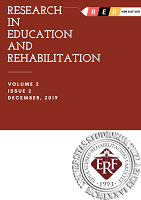OVERVIEW OF SOME INTERNALIZED AND EXTERNALIZED BEHAVIOURAL PROBLEMS IN PRIMARY SCHOOL STUDENTS WITH REGARD TO GENDER
OVERVIEW OF SOME INTERNALIZED AND EXTERNALIZED BEHAVIOURAL PROBLEMS IN PRIMARY SCHOOL STUDENTS WITH REGARD TO GENDER
Author(s): Emina Suljkanović-Djedović, Lejla Kuralić-Čišić, Meliha Bijedić, Adela JahićSubject(s): School education, Behaviorism
Published by: Edukacijsko-rehabilitacijski fakultet Univerziteta u Tuzli
Keywords: Internalized and externalized problems; primary school; risky behaviours; prevention;
Summary/Abstract: The aim of the study was to identify differences in the representation of individual externalized and internalized behaviours with regard to the gender of the respondents. The sample of respondents in this study consists of 450 primary school students (both genders). The survey was conducted in the first semester of 2017/18. The Achenbach System of Empirically Based Assessment (ASEBA Youth Self-Report - YRS; Achenbach, 2007) was used for the purposes of this study. The instrument measures adaptive functioning and competencies and maladaptive functioning, that is, behavioural, emotional and social problems between the ages of 11 and 18. T-test and descriptive statistics methods were used in the data processing. It was observed that externalized problems were statistically significantly more prevalent in male (t=233; p<0.001) and internalized problems are more prevalent in female respondents (t=p<0.001). In addition, boys had statistically significantly higher scores on the Social problems and Rules-violating behaviours sub-scales. Girls had statistically significantly higher scores on the Anxiety / Depression, Somatic problems, and Thinking problems sub-scales. Through interpretation of the obtained results, it can be concluded that the considered psycho-social characteristics of students (gender) significantly contributes to the phenomenology of internalized and externalized behaviours, which suggests the possibility and justification of creating different interventions aimed at preventing risky behaviours of different groups of children and young people.
Journal: Research in Education and Rehabilitation
- Issue Year: 2/2019
- Issue No: 2
- Page Range: 1-10
- Page Count: 10
- Language: English

